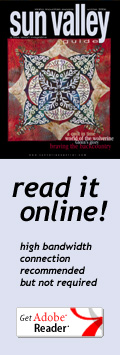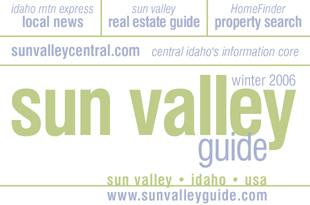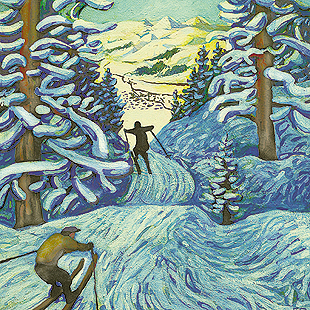| Current Issue |
| View as .PDF |
| features |
| Art walks |
| Wolverines |
| 1950s Sun Valley |
| Hillard Hicks |
| arts |
| Raku |
| Quilting |
| Glenn Janss & SVCA |
| living |
| Giving |
| Solar Power |
| Small Spaces |
| recreation |
| Kiteboarding |
| Backcountry Education |
| Vintage SV chairlifts |
| dining |
| Omlettes |
| Trail cuisine |
| Coffee |
| calendar |
| Winter 2006 |
| listings |
| Galleries |
| Dining |
| Fitness |
| Lodging |
| Equipment |
| Outfitters |
| maps |
| Ketchum & Sun Valley |
| Gallery Map |
| the guide |
| Last Fall |
| Editorial Submission |
| Calendar Submission |
| Advertising Submission |
| Advertising Rates |
| About Us |

|
|
Copyright
© 2005 Express Publishing Inc. All Rights reserved. Reproduction in whole or in part in any form or medium without express written permission of Express Publishing Inc. is strictly prohibited. The Sun Valley Guide magazine is distributed free twice yearly to residents and guests throughout the Sun Valley, Idaho resort area communities. Subscribers to the Idaho Mountain Express newspaper will receive the Sun Valley Guide with their subscription. |


Illustration by Gavin McNeil
Memories of a magical Sun Valley
Don Nielson recalls
the
rarefied resort in the '50s
By Don Nielson
It was the mid-1950s, and those of us who lived in Idaho probably didn’t have the image of Sun Valley that its publicity people and the national press had generated. As a destination resort, it didn’t bother to cultivate that image for its outlying Idaho neighbors. Sure, we knew a little of the elegance imposed on the Wood River Valley as it became a hideaway for the luminaries we had met only on the screen.
But more than anything we, in our late teens, saw it as the best and most exciting place we could go to ski. Its chairlifts were a world apart from the rope tows, T-bars and Pomalifts that tugged us up our local slopes. So, Sun Valley had enough allure that we wanted to travel the four hours or so from Pocatello, Idaho, once a year to ski, and quite incidentally, to sample the “good life.”
But, as certain as the fluffy snow, there was this inevitable constraint imposed on even a single trip: money or, more precisely, the lack thereof.
After all, we would be leaving Idaho for this rarified resort that had been financially walled off within our state. We knew it would be open to us, however, if we could just figure out how to afford its costs.
Armed with the lofty purpose of good skiing and clearly not outfitted for hobnobbing with the normal Sun Valley patrons, the cloud of affordability still hung over every planning moment. Five or six would cram into a car for the journey, along with considerable food, ski and sleeping gear.
Reservations of any kind were unnecessary since we couldn’t afford to stay any place they were needed. Our predecessors had figured a way, and we were going to follow.
First, however, let me sketch the scene we found in Ketchum in the 1950s.
Ketchum was a terminus for the railroad, and in the area where the light industrial section now lays in the north part of town was a loop around on which the trains would reverse direction to return to Twin Falls.
Alongside that loop a number of railroad boxcars had been placed for the work crews that maintained the railroad during the summer. In wintertime, the cars had nothing in them save a small monkey stove. Fortunately, the doors were locked with a switch-key lock, common to the railroad and even more common in a railroad town like Pocatello. So, a key was not hard to find and, thus, one of these empty, un-insulated cars would be our home in elegant Sun Valley. After all, Averell Harriman owned both Sun Valley and the boxcars, so these were simply outlying rooms of either the Inn or the Lodge; we could take our pick.
Unlike their richer cousins, luxury had nothing to do with our accommodations. The lighting was from a single bulb dangling somewhere from the ceiling. Occasionally, a set of cot springs might be left there and the one of us requiring, by acclamation, the most pampering would get to place his sleeping bag there. The rest would bed down on the wooden floor.
Heat was always a problem, for the nights could get very cold. We would rustle wood or coal for the stove, and stoking it to its maximum would heat the boxcar so intensely we would sweat in our sleeping bags until the fire went out. Then, after an hour or two of sublime temperature, it would turn freezing cold again.
In retrospect, it seems so simple to have taken turns stoking the stove moderately through the night, but I don’t recall that coming to mind. You can see from this sketch, and the lack of running water or facilities, why we tried not to spend too much time in our “room.”
Fortunately, there was a quite natural place for a set of young men, not exactly oriented to the bars of Ketchum, to while away their aprés-ski time—Sun Valley itself.

There was one particular place we liked to spend our evenings. In its traditional way of caring for its guests, the Sun Valley Company had created a room in the basement of the Inn oriented toward teenagers. I don’t recall its name, but you could go there to play ping-pong or pool. I remember playing ping-pong with the likes of Walt Disney’s daughter, Diane. But, best of all was the singing. The establishment would pass out songbooks and accompany us in singing the songs of skating or skiing and mildly earthy tunes like “The Virgin Sturgeon,” the words of which I still recall 50 years later.
After the festivities in the Inn, we would visit the restrooms and head off to our appointed place not far from the mansions of north Ketchum today.
As it turns out, there was one other minimalist lodging option in Ketchum. One year a few of this same group of lads had taken the train from Pocatello, arriving in Ketchum on the day before the new year began. Once there, they found no rooms available they could afford and what boxcars they could get into were similarly occupied. The situation looked bleak. Then someone mentioned that the Ketchum jail offered some shelter.
The jail was small with three or four cells on the main level and a loft upstairs with some benches. But, more importantly, the friendly town constable made them available. Some laid out on the upstairs benches and some on cots in the cells. It was a warm place to stay, but for just one night. As it turned out, the loft and its benches were used for a church service the next morning.
Once past the lodging problem, there were the lift tickets to contend with. Here, too, Sun Valley was wonderfully accommodating. The entrance to Bald Mountain in those days was at River Run where the chairlift extended to the town side of the river. That chairlift access point, as it turned out, was the only place on the mountain where lift tickets were checked. While not exactly proud of our scheme, it was easy to buy two lift tickets to ferry five or six of us to the upper slopes where we would remain all day. It cut the cost of skiing by about two thirds of a price that today would be tantamount to free. I don’t remember exactly how we rationalized the guilt but there were a number of options.
One other aspect of our vacation to this utopia needs mentioning, and that is the weather.

Don Nielson (third from left) and his friends infiltrated Sun Valley Resort once a year to ski and sample "the good life."
In typical Sun Valley tradition, I recall the days being sunny and clear and the nights being cold, sometimes very cold. The blankets on the chairlift seemed more necessity than convenience, given the clothing of the time. The other occasional weather aspect that I still have found no explanation for regards the unique ability a clear Sun Valley night sky has to snow.
I recall going into the boxcar at night with the cold stars holding forth, and emerging in the morning to totally clear skies and yet finding a few inches of whiffy snow all around. It seemed as though this magical place could even command snow from perfectly clear skies and at a time when it would be least intrusive, at night.
But now to the final accounting: what did all this high living set us back? My dim recollection is that five days and four nights would come to the order of $18, including gas and ski wax. Most of the food came with us and little came home.
The whole picture may not have been so appealing as it now seems, but it was fantastic. Time cannot erase the cold mornings in the boxcars, but everything else about those trips is a happy and equally indelible memory. •